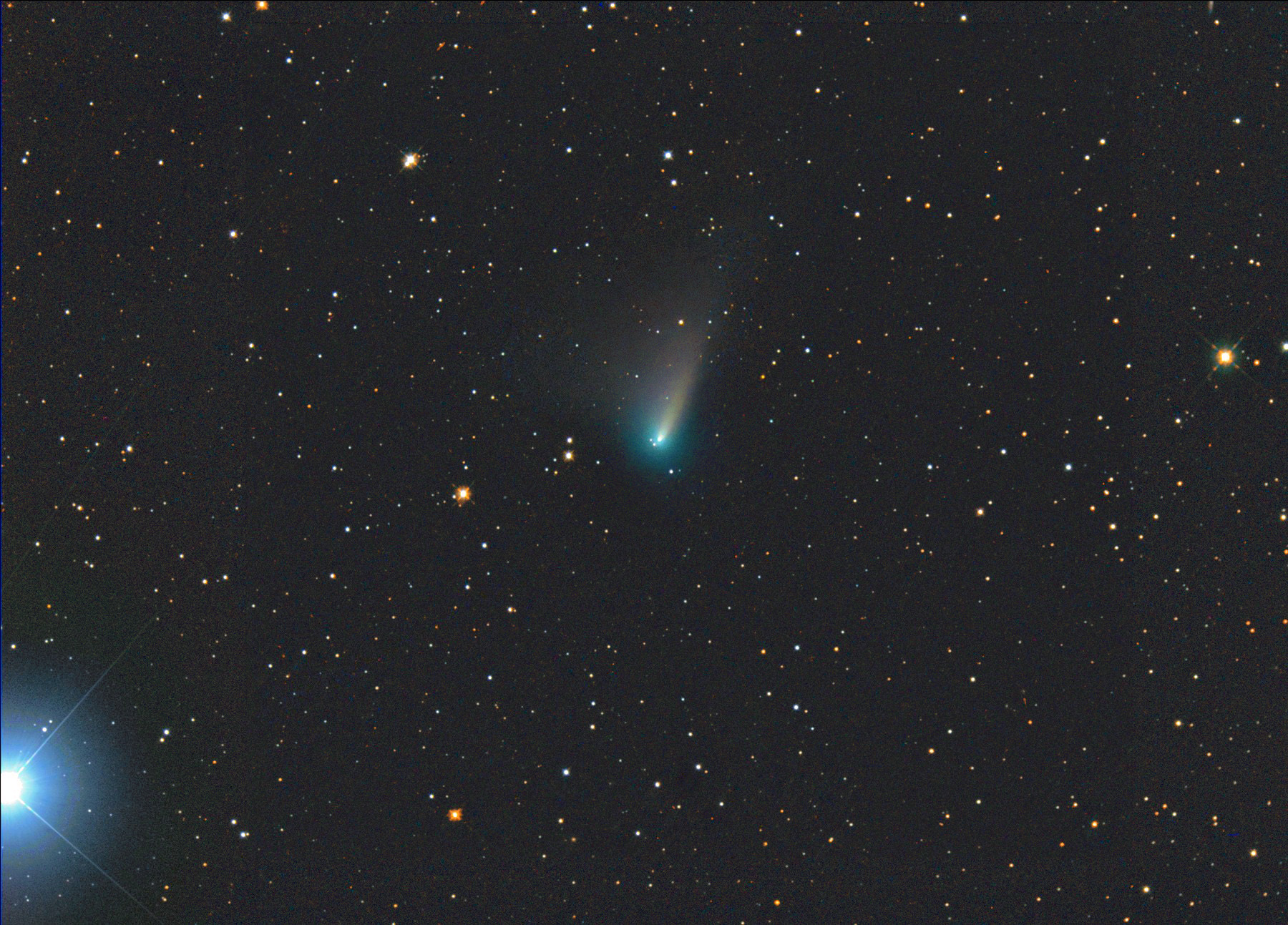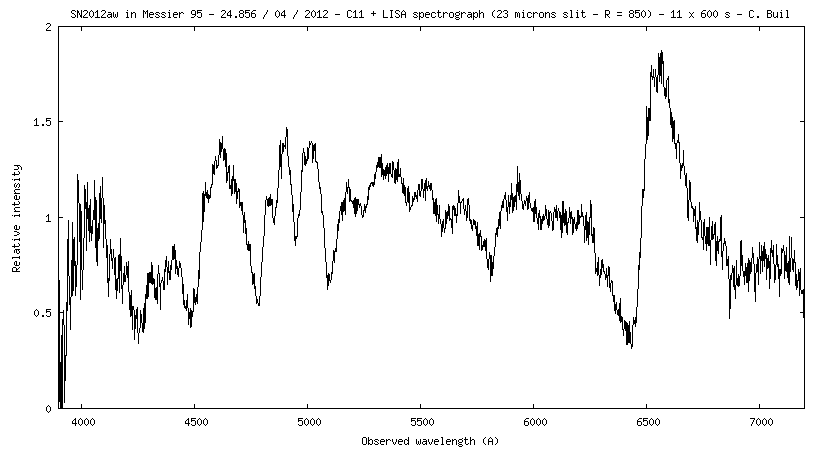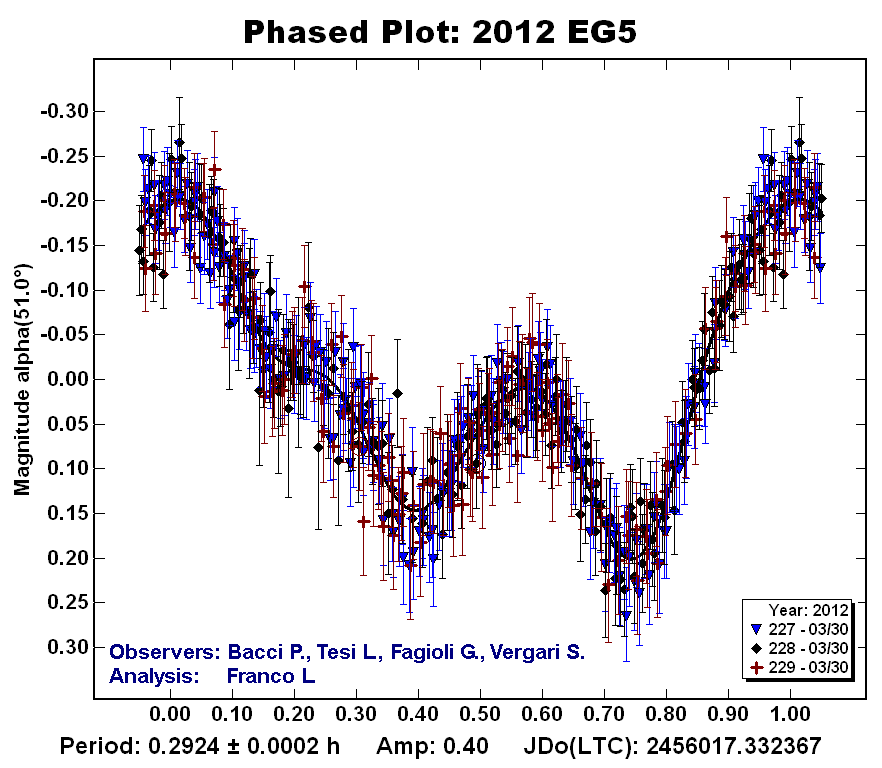I'd like to share the experience of my first asteroid discovery using remotely controlled
SSON telescope. If you get interested in discovering one yourself I hope this will be a good read to start with. Even though many new asteroids are discovered each month and one may argue that with the advancement of automatic surveys the value of each individual asteroid discovery greatly diminished, trust me - finding an asteroid on your own is a lot of fun!
I got interested in asteroids when I stumbled on the
Eros and the Solar Parallax website. In this on-line project Steven van Roode and Michael Richmond asked people around the world to take photographs of the famous Near-Earth asteroid (433) Eros at a certain time during the night, measure its position relative to stars and compare the results. Since the asteroid was passing close to Earth it was seen in a slightly different point of the sky from different parts of the world. This is how almost a hundred years ago astronomers were able to accurately measure the size of the solar system. So I took photos of Eros from my backyard, learned how to use Astrometrica and sent my results in (one of my photos even got
published). I had so much fun doing that that I decided it was absolutely necessary to discovery an asteroid myself!
To discover an asteroid these days you need a pretty big telescope, because all big and therefore bright objects have already been found. Luckily, now there is a growing network of remotely-controlled professional-grade telescopes that anyone can use for a very affordable price. My favorite is the
Sierra Stars Observatory Network.
On March 3, 2012, less than a week before the full Moon, I took five photographs of the night sky using
Mt. Lemmon 0.81-m telescope. I targeted a small area of the sky between the coordinates RA 11:00 ... 11:30 and DEC +18 ... +23. To get an idea where that is - this is a small rectangular area located in the upper left corner of the constellation
Leo, close to the star delta Leo named Zosma. I scheduled four 120 second exposures per field with 15 min interval. This sequence of photographs allows imaging rather faint objects and detecting their movement. I chose the fields about a month ahead of the opposition point and just high enough above ecliptic to avoid areas already photographed by major surveys during the past month - just like Rich Williams describes in his
Guide.
My target area is shown in the following sky coverage plot from the Minor Planet Center (MPC). Each square on this plot represents the field of view of one of the major surveys: Catalina Sky Survey, LINEAR, Mt Lemmon Survey, etc... Most of the observations cluster around the plane of the Solar System (a sinusoidal-shape line that runs across the plot). This is where most of the asteroids reside. As you can see, the area in the middle of the plot where the ecliptic crosses the vertical line is the most observed in the sky. This region is called the "Opposition Point" - a direction in space directly opposite the Sun as seen from Earth. In this direction the asteroids reach their brightest magnitude, because they are fully illuminated by the Sun and located at the closest distance from our planet. The Opposition Point is constantly shifting to the east as the Earth travels around the Sun. Many smaller asteroids are very faint away from the opposition point so that even the most powerful telescopes can't see them there. They appear from the darkness of space for a short time near the opposition and disappear again... unless you discover them!
.png)
I looked through the fist two images and didn't find anything new. In the third field I quickly found two numbered minor planets:
226068,
47046 and one unnumbered -
2005 UM223. The unnumbered asteroid was the faintest at +20.3. Since I couldn't detect 258461, which was also supposed to be in the field of view, I estimated my limiting detectable magnitude somewhere at around +20.8. I was almost at the bottom of the image when I noticed a faint object of +21 magnitude, which was moving just like a typical Main Belt asteroid. I measured its position in Astrometrica and rushed to the Minor Planets Center website to check whether this asteroid had already been discovered by someone. It was not!
Here's a succession of three discovery images. It does take a little practice to see the asteroids among all that CCD image noise, so I recommend you to click on the image to make it bigger and stare at the object for a few seconds to make sure you can see it.
Here's where it was located in the constellation of Leo:

Since the asteroid was new, I gave it a temporary designation AVK0002 and quickly emailed my report to the MPC. Here's how it looked:
COD G84
OBS A. Kostin
MEA A. Kostin
TEL 0.81-m f/7 Ritchey-Chretien + CCD
ACK MPCReport file with AVK0002
NET PPMXL
AVK0002 C2012 03 03.42520 11 25 03.37 +17 56 22.9 20.8 V G84
AVK0002 C2012 03 03.42762 11 25 03.30 +17 56 23.3 20.9 V G84
AVK0002 C2012 03 03.43763 11 25 02.75 +17 56 29.9 20.9 V G84
AVK0002 C2012 03 03.44799 11 25 02.20 +17 56 36.3 20.9 V G84
This is a special format used to report all observations to the Minor Planet Center and it basically contains information about the observer, equipment used, date and time and the coordinates of the object.
Once the report was sent I started planning the follow-up observations. Asteroid discoveries can only be granted if reported on two nights. One-night observations don't count. Main Belt asteroids move fast enough near opposition covering roughly 12 arc-minutes per day, so you can't simply re-take the photo of the same field a couple of nights later and confirm the asteroid - it will be gone! Hence the position of the asteroid for the follow-up session needs to be predicted based on the limited amount of data collected during the discovery night. The more you delay the follow-up observations, the more uncertain this prediction becomes!
It was already too late to schedule the follow-up session at Mt. Lemmon on the 4th of March, so I went ahead and calculated the ephemerides for the 5th. The Full Moon was coming on the 8th and with each day the period of dark skies, when the Moon was below the horizon shortened. My asteroid was so faint, that it would have been impossible to image with the full Moon high up in the sky. Moreover, I could only detect the asteroid when it was high above the horizon to limit the distorting effect of the atmosphere. So I had to schedule the imaging session late enough at night to make sure the Moon was low and at the same time early enough to be able to image the object as close to the meridian as possible. Each night the "window of opportunity" shortened. If I waited two more days I would've probably lost the asteroid!
This chart shows the predicted coordinates as calculated by the MPC routine. I punched them into the telescope scheduler and went to sleep.
Needless to say I was very exited to receive FITS files from Mt. Lemmon on the 5th! I was worried that the seeing hand't been good last night in Arizona or maybe I did something wrong and I wouldn't find it! But I didn't have to worry. Here it was - AVK0002 - just a few arc-seconds away from predicted location (shown with a cross-hair in the image below).

I sent my second report to MPC and waited. I expected to receive a reply from them with the provisional designation of my discovery. I waited some more. I even checked my iPhone while brushing my teeth in the morning. No reply. A few days later tired of not hearing from them I went to the MPC website and did minor planet search with the coordinates of my discovery. When I did this (many times) previously I found no object at that location. Now suddenly 2012 EO4 appeared. Wow! They gave the designation, but didn't let me know... The discovery started to feel less significant for a moment. I realized that this month my designation was probably among hundreds of others and considering that so far I was the only observer of 2012 EO4 it was probably not high on the priority list at MPC. So what? This is my asteroid after all!
Since there was no orbit calculated at the MPC website I decided to do it myself. Which meant I probably needed more measurements of its position to make the observing arch longer. Since it was the time of the full Moon I had to wait for a couple weeks before the skies got dark again. Luckily now I had 2 days worth of data and the accuracy of the short-term predictions improved significantly.
Without any trouble I recovered the asteroid on March 13. By then it had progressed quite a long way following the direction of Leo's tail. I sent the new report to MPC, but this time although they acknowledged its receipt they didn't even add my new observations to their database. Probably I screwed up something in the reporting protocol.
Since there was still no orbit calculated at MPC, I used Project's Pluto
Find_Orb software to do it and here's what I got:
Orbital elements:
AVK0002
Perihelion 2012 May 23.988623 TT = 23:43:37 (JD 2456071.488623)
Epoch 2012 Mar 8.0 TT = JDT 2455994.5 Earth MOID: 0.7492
M 337.28657 (2000.0) P Q
n 0.29502315 Peri. 99.26402 -0.92145755 0.37123559
a 2.23476560 Node 102.59473 -0.38627611 -0.84423150
e 0.2229568 Incl. 6.73502 -0.04131271 -0.38659706
P 3.34 H 19.4 U 7.3 q 1.73650924 Q 2.73302196
From 11 observations 2012 Mar. 3-13; mean residual 0".158.
This basically means that I discovered a
Main Belt Asteroid which flies between the orbits of Mars and Jupiter with the period of 3.34 years. Its average distance to Sun is about 334 million kilometers, but due to its elliptical orbit it sometimes approaches Sun within 260 million kilometers and can be as close as 109 million km to Earth (the distance from Earth to Sun is roughly150 million km). Its orbit is inclined with at nearly 7 degrees respect to the ecliptic. Assuming an albedo of .15 the asteroid size is approximately 400m.
Find_Orb software can also predict when this asteroid will be visible again at the next opposition. This is important, because to name this object (for example, after a famous jazz musician :) it must be observed during several oppositions.
So the future looks like this:
2012 EO4 will fade out quickly and by June-July 2012 I will lose it (I am going to measure it again in April to reduce the uncertainties).
Due to orbit eccentricity and inclination the next two observing opportunities will be :
2 January 2015 when it will be visible as a dim +21.9 magnitude object in Gemini
10 June 2019 when it will be about the same brightness as this time (+20.8) and travelling through the dense star fields in Ophiuchus.
PS:
MPC publishes the Minor Planets Circular every month, where all new discoveries as well as observations of known objects are summarized. It is a very dry publication with lots of numbers and not a single picture. However, it was like the best sci-fi book for me when I looked through the April issue. Here's what I found:
Here is the position of 2012 EO4 on the discovery date:
2012EO4 is now official!



























.png)











